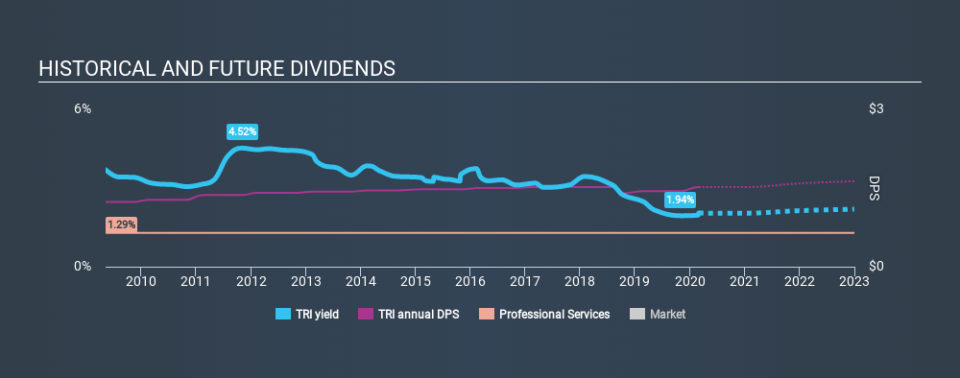Income Investors Should Know That Thomson Reuters Corporation (TSE:TRI) Goes Ex-Dividend Soon

Some investors rely on dividends for growing their wealth, and if you're one of those dividend sleuths, you might be intrigued to know that Thomson Reuters Corporation (TSE:TRI) is about to go ex-dividend in just 4 days. If you purchase the stock on or after the 5th of March, you won't be eligible to receive this dividend, when it is paid on the 18th of March.
Thomson Reuters's next dividend payment will be CA$0.38 per share, on the back of last year when the company paid a total of CA$1.52 to shareholders. Calculating the last year's worth of payments shows that Thomson Reuters has a trailing yield of 2.0% on the current share price of CA$99.71. If you buy this business for its dividend, you should have an idea of whether Thomson Reuters's dividend is reliable and sustainable. We need to see whether the dividend is covered by earnings and if it's growing.
Check out our latest analysis for Thomson Reuters
If a company pays out more in dividends than it earned, then the dividend might become unsustainable - hardly an ideal situation. Fortunately Thomson Reuters's payout ratio is modest, at just 46% of profit. That said, even highly profitable companies sometimes might not generate enough cash to pay the dividend, which is why we should always check if the dividend is covered by cash flow. Over the last year, it paid out dividends equivalent to 356% of what it generated in free cash flow, a disturbingly high percentage. Our definition of free cash flow excludes cash generated from asset sales, so since Thomson Reuters is paying out such a high percentage of its cash flow, it might be worth seeing if it sold assets or had similar events that might have led to such a high dividend payment.
While Thomson Reuters's dividends were covered by the company's reported profits, cash is somewhat more important, so it's not great to see that the company didn't generate enough cash to pay its dividend. Cash is king, as they say, and were Thomson Reuters to repeatedly pay dividends that aren't well covered by cashflow, we would consider this a warning sign.
Click here to see the company's payout ratio, plus analyst estimates of its future dividends.
Have Earnings And Dividends Been Growing?
Companies with consistently growing earnings per share generally make the best dividend stocks, as they usually find it easier to grow dividends per share. If earnings fall far enough, the company could be forced to cut its dividend. This is why it's a relief to see Thomson Reuters earnings per share are up 3.8% per annum over the last five years. Earnings have been growing somewhat, but we're concerned dividend payments consumed most of the company's cash flow over the past year.
Many investors will assess a company's dividend performance by evaluating how much the dividend payments have changed over time. In the last ten years, Thomson Reuters has lifted its dividend by approximately 2.1% a year on average. We're glad to see dividends rising alongside earnings over a number of years, which may be a sign the company intends to share the growth with shareholders.
Final Takeaway
From a dividend perspective, should investors buy or avoid Thomson Reuters? Thomson Reuters delivered reasonable earnings per share growth in recent times, and paid out less than half its profits and 356% of its cash flow over the last year, which is a mediocre outcome. While it does have some good things going for it, we're a bit ambivalent and it would take more to convince us of Thomson Reuters's dividend merits.
Ever wonder what the future holds for Thomson Reuters? See what the 14 analysts we track are forecasting, with this visualisation of its historical and future estimated earnings and cash flow
If you're in the market for dividend stocks, we recommend checking our list of top dividend stocks with a greater than 2% yield and an upcoming dividend.
If you spot an error that warrants correction, please contact the editor at editorial-team@simplywallst.com. This article by Simply Wall St is general in nature. It does not constitute a recommendation to buy or sell any stock, and does not take account of your objectives, or your financial situation. Simply Wall St has no position in the stocks mentioned.
We aim to bring you long-term focused research analysis driven by fundamental data. Note that our analysis may not factor in the latest price-sensitive company announcements or qualitative material. Thank you for reading.

 Yahoo Finance
Yahoo Finance 
